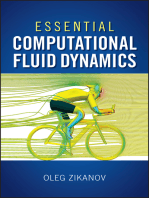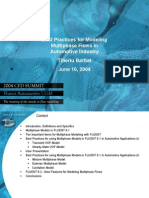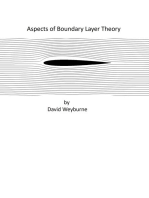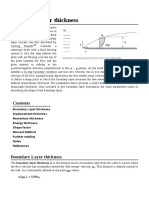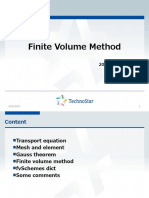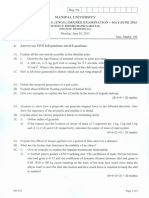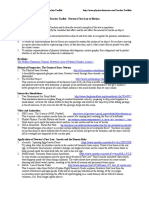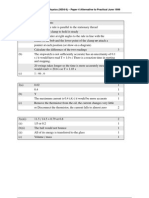External Incompressible 3D CFD Analysis OpenFOAM Tutorial
External Incompressible 3D CFD Analysis OpenFOAM Tutorial
Uploaded by
sumohiCopyright:
Available Formats
External Incompressible 3D CFD Analysis OpenFOAM Tutorial
External Incompressible 3D CFD Analysis OpenFOAM Tutorial
Uploaded by
sumohiOriginal Description:
Copyright
Available Formats
Share this document
Did you find this document useful?
Is this content inappropriate?
Copyright:
Available Formats
External Incompressible 3D CFD Analysis OpenFOAM Tutorial
External Incompressible 3D CFD Analysis OpenFOAM Tutorial
Uploaded by
sumohiCopyright:
Available Formats
1.
Backg
2. Case
3. 3d Mo
4. Units
5. Phys
6. Mesh
7. Struc
8. Settin
9. Solvin
10. Post
11. Gene
ground
Introduction
odeling
ical Paramete
hing with Gms
cturing the cas
ng up the case
ng the case
processing
ral Sources:
Exter
rs
h
se folders
e
rnal Incompres
Open
Eng. Se
www.libr
ssible 3D flow
FOAM Tutoria
bastian Rodrig
remechanics.c
w CFD Analysi
al
guez
com
s
External Incompressible 3D flow CFD Analysis OpenFOAM Tutorial
Eng. Sebastian Rodriguez www.libremechanics.com
2
External Incompressible 3D Analysis
OpenFOAM (Open Source Field Operation and
Manipulation) its an Open Source Software project claim
to be one of the best CFD tools currently available, the
constant development and its highly technical structure,
the fine implementation of common solvers and the
possibility to edit and create equations and mathematical
cases make OpenFOAM useful tool on researching.
OpenFOAM is a C++ toolbox for the development of
customized numerical solvers, and pre-/post-processing
utilities for the solution of continuum mechanics problems,
including computational fluid dynamics (CFD). The code
is released as free and open source software under the
GNU General Public License
In common plastic analysis, deformations are easily
inferred, but de fluid computational dynamics its
governed by a wide group of less known physics
laws and variables that make the results almost
unpredictable by simple observation
As the user is probably aware by now, this document
make a number of simplifying assumptions as the tutorial
progressed, this is done in the interest of gaining a clearer
understanding of the fundamental without getting bogged
down in special details and exceptions. By no means it
hast the complete history of external 3D fluid analysis
handling on OpenFoam, it is much broader in scope that
can be presented in a single document such as this, but it
is sincerely hoped that this tutorial will enable one to do a
better job on the definition, solution and study of this kind
of analysis.
Background
The external flow CFD analysis are commonly used to
study the behavior of objects submerged in continuous
non static fluids, it aims to determine how efficiently a
body can move throw the medium and how they affect
each other in the process.
Here the fluid its no confined between wall type
conditions such as pipes or confined flow cases, the fluid
its free to move around the object and interact only with
its external wet layer, this means that there is the flow
involving the body shape what must be analyzed not the
core.
Evaluating the pressure distribution on the structure
generated by the resistances of the fluid the engineers
can optimize the design to decrease the amount of
energy needed to move the body or the disturb impact on
the fluid patch that leaves the pass of the structure.
This tutorial its based over the at
www.LibreMechanics.com Simple Openfoam 3D tutorial
at http://www.libremechanics.com/?q=node/25
Case introduction.
This basic tutorial its design to be a guide for the creation
of simple external incompressible 3D flow cases on
OpenFOAM, it must be complemented with further
reading and understanding of FEA and CFD theory and
by no means this tutorial most replace the although
complex yet useful documentation from OpenFOAM itself
and related sources.
In this case, the dummy Kilo-Class submarine model its
completely submerged under water and its advancing
completely straight throw the water medium. It is no
common to have an small restricted medium-- boundary
like in this example, the user must be careful in make the
right assumptions in this type of procedure, the
dimensions of the medium affects the turbulence model
and may lead to unreal results.
According to merely informative sources this type of
submarine has a maximum submerged velocity of 25
knots (12.86 m/s) , but for this first reference simulation
the speed will be limited to 10 knots (5.14 m/s). No
additional forces, velocitys, or pressure points will be
configures over the model, the only goal of the case its to
determine the flow path over the submarine surface.
In real design process not just the hydrodynamic behavior
dictates the submarine shape, it involves some deep and
complex studys which naval engineers master. This
analysis its completely representative and
educational due the lack of real data such as
dimensions, velocity and materials properties the model
has been created by merely observation and assimilation
of some real cases.
Image 1 Kilo-Class submarine, no attribution.
External Incompressible 3D flow CFD Analysis OpenFOAM Tutorial
Eng. Sebastian Rodriguez www.libremechanics.com
3
3D Modeling.
The model was create using merely observation of a Kilo-
Class submarine completely submerged on a continuous
media, the model stands completely separate form any
external surface in horizontal position and align to the X
axis.
The whole external surface is made by spline revolutions
and curved ends, the meshing of this kind of surfaces will
be explained at the Meshing section.
A single body model was created for the submarine,
geometry as hatches, propeller, periscope and others
were ignored on purpose to keep the model as simple as
possible keeping its characteristic shape. Some basic
rules as non-negative or cero volume sections on the
model are also respected for this 3D model in order to
perform an optimal and simple discretization.
The dimensions of the fluid domain respond to an
acceptable volume where the fluid can develop its total
turbulence , The distance between the domain external
layers and the model can affect the pressure or velocitys
on the model, The bigger the fluid domain is it will be a
greater load to the meshing process and it will require
much more memory to perform the analysis and even to
compute the result files.
After the model was created a mold surrounding volume
counterpart was created to match the external surface in
a hollow cavity, this is done by most common CAD tools,
the final hollow model has the next characteristics:
Image 2 Kilo-Class representative sketch, no attribution
Image 3 CAD core model.
Image 4 3D water volume model, cut.
Water External Domainl:
Lenght : 130m
Width: 50m
hight: 50m
Total water volumen: 319000 m
Submarine Model (hole):
Lenght : 70m
Width: 20m
hight: 20m
Units
http://www.openfoam.org/docs/user/basic-file-format.php
Units on OpenFoam need to be set in order to be
accepted by the solver, the program makes an early
check for units congruency and stops if anything unusual
is detected. In this case there is no need for unit
combinational scheme as other FEA tool which makes
easiest the reading of results.
No. Property SI unit USCS unit
1 Mass kilogram (kg)
pound-mass
(lbm)
2 Length metre (m) foot (ft)
3 Time second (s)
4 Temperature Kelvin (K)
degree
Rankine (R)
5 Quantity
kilogram-
mole (kgmol)
pound-mole
(lbmol)
6 Current ampere (A)
7
Luminous
intensity
candela (cd)
Example: [0 2 -1 0 0 0 0]
External Incompressible 3D flow CFD Analysis OpenFOAM Tutorial
Eng. Sebastian Rodriguez www.libremechanics.com
4
Where each of the values corresponds to the power of
each of the base units of measurement listed in Table.
The table gives the base units for the International (SI)
and the United States Customary System (USCS) but
OpenFOAM can be used with any system of units. All that
is required is that the input data is correct for the chosen
set of units. It is particularly important to recognize that
OpenFOAM requires some dimensioned physical
constants, e.g. the Universal Gas Constant.
Physical parameters
The fluid of interest in this case its common sweet water,
incompressible fluid.
It is assumed that the pressure drops are not enough to
fall below the vapor pressure of the water and make any
phase change during the analysis, so the solver chosen is
the SimpleFoam for incompressible fluids:
Density: 1000 kg/m^3
Kinematic Viscosity: 1,0 e-6m^2/s
Inlet velocity: 5,14 m/s
k =
2
S
(u
i
x
2
+u
i
2
+u
i
z
2
)
e =
u,u9 k
0.75
B l
The turbulence model used k-Epsilon in external flows
applications has special considerations depending of the
application, it may be even not recommended for special
turbulent models
The E model needs an special configuration where the
medium dimensions are considered, since the is not an
external 0 velocity layer (wall) limiting the vortex energy
transfer there is not a standard Specific Length magnitude
to compute the energy dissipation equation (E), therefor
the external combined dimensions of the inlet face and a
multiplier factor B can be manipulated to reach a
substantial and stable solution to the case.
k =
2
S
(u
i
x
2
+u
i
2
+u
i
z
2
)
u
i
x
2
= u
i
2
= u
i
z
2
k =
2
S
(u.2S7
2
)
k = u,u44uSm
2
s
-2
e =
u,u9 k
0.75
B l
e =
u.u9 u,u44uS
2
m
2
s
-2
u,u1 2Suu
e = 6,9791
-6
m
2
s
3
Meshing with Gmsh
Even though OpenFOAM have a build in tool called
blockMesh for multi-block simple geometry meshing,
there is a need in CFD for multiple meshing tools that
cover a range of complexity meshing task.
Gmsh is a 3D finite element grid generator with a build-in
CAD engine and post-processor. Its design goal is to
provide a fast, light and user-friendly meshing tool with
parametric input and advanced visualization capabilities.
Gmsh is built around four modules: geometry, mesh,
solver and post-processing. The specification of any input
to these modules is done either interactively using the
graphical user interface or in ASCII text files using
Gmsh's own scripting language.
The Gmsh meshing process begins at the import
of the CAD geometry, many formats are
supported by the tool, depending de CAD used
to create the model the user may choose the
correct format, in this case the model is saved as
a .XX file, opening the file the main shape can
be checked for any overlap geometry.
Image 5 CAD inported on Gmsh.
The boundary are created before the meshing
process, using the inside tool of Gmsh of
physical parameters we can choose the faces
from the model and selecting them together to
create the boundary groups, note that the
Graphical View of Gmsh wont ask the set name
or any other identification, it just create a
consecutive set (1,2,3 ) with the group of faces
are selected.
External Incompressible 3D flow CFD Analysis OpenFOAM Tutorial
Eng. Sebastian Rodriguez www.libremechanics.com
5
Image 6 Boundary sets in Gmsh.
To finish the set creations the file case.geo must
be changed to give the sets the real names that
will be used in the processing of the analysis,
changing the name between the parenthesis the
user can give costume names to the sets, for this
tutorial the case.geo file must look something
like this:
It is possible and even easier to create the case.geo file
from scratch without the use of the Gmsh GUI, but the
user must know for sure the identification of the faces;
wich one are walls, inlets, outlets and such.
Just meshing the volume wont be enough to create a
good preprocessing model, in this type of analysis the
density of the mesh are quit important, to maintain the
result consistency; in contrast, other FEA elastic material
analysis may use special density concentration on some
model places like angles, holes or irregular shapes; but
this type of analysis require a uniform density to precisely
predict the flow velocity on the medium.
The element size can be selected before the
mesh process on the Options menu and
advanced tab, experimentation and experience
may lead to a good element size, it is
recommended to star in a moderate big element
size (coarse mesh) and compare results as the
mesh becomes thinner, a good pint to stop will
be where the resulting data change over the
change on the mesh does not exceed the 1% of
magnitude.
Image 8 Element size configuration Gmsh.
After the process, we check the quality of the
mesh, quantity and size of elements and nodes,
and finally save it as a Gmsh file case.msh
o Nodes : 193.637
o Elements: 1,080,753
The export process is t done by a tool named
gmshToFoam, a common OpenFoam installation
already have this tool available and it doesnt
require any configuration to used, just the
command:
gmshToFoam case.msh
This will create the mesh files on the file
Constant on the case folder.
Image 7 Mesh from cavity model.
E
E
S
T
s
f
c
T
c
o
t
t
d
c
f
p
S
c
d
External Incom
Eng. Sebastian
Structuring th
The case defin
information, se
structure which
Many pre-proc
folders by de
change param
This gives any
changes over
parameters ca
other part of t
the time step
those who are
denotes the
conditions are
The initial case
from Libre Me
portal
Setting up the
Even if the m
import proces
characteristics
definition:
http://www.ope
2
(
I N
{
}
WA
{
}
)
mpressible 3D
n Rodriguez
he case folders
nition is not a
everal files an
h order is man
cessing tool fo
efault for the
eters.
y case great fle
r the mesh, b
an be easily
he case. Time
s data which
solved by the
first time ste
save it.
e folder for this
echanics web
e case
mesh files whe
ss from Gmsh
most be chan
enfoam.org/doc
TYPE
NFACES
STARTFACE
ALLS
TYPE
NFACES
STARTFACE
D flow CFD An
s
simple file con
nd folder const
ndatory for any
orm OpenFoam
user just to
exibility and sc
boundary con
changed witho
e directions are
constrain the
process, norma
ep where so
s tutorial can b
page or the
re already cre
h, the bounda
nged dependin
cs/user/bounda
PATCH;
102442;
1884376;
WALL;
8410;
1986818;
nalysis OpenF
ntaining all the
titute the case
y solver to run
m create some
complete and
calability where
ditions, solver
out affect any
e the folder for
e analysis and
ally a 0 folder
ome boundary
be downloaded
Source Forge
eated form the
ary conditions
ng on the case
aries.php
;
;
FOAM Tutorial
6
e
e
.
e
d
e
r
y
r
d
r
y
d
e
e
s
e
The
desc
edite
l
0 folder file
ribed in the p
ed as bellow:
U----------
DI MENSI O
I NTERNA
BOUNDAR
{
I N
{
TYP
VAL
0. 000000
}
WALLS
{
TYP
VAL
}
}
E-----------
DI MENSI O
I NTERNA
BOUNDAR
{
I N
{
TYPE
VAL
}
WALLS
{
TYP
EPSI LONW
VAL
}
}
K---------
DI MENSI
I NTERNA
BOUNDA
{
I N
{
TYP
VAL
}
WALLS
{
TYP
VAL
www.l
es respond t
previous chap
-----------------
ONS [ 0 1 -
LFI ELD UNI F
RYFI ELD
E FI X
UE UN
0. 0000);
E FI X
UE UN
-----------------
ONS [ 0 2 -
LFI ELD UNI F
RYFI ELD
FI XEDVA
UE UN
E
WALLFUNCTI
UE UN
----------------
IONS [ 0 2
ALFIELD UN
ARYFI ELD
PE F
UE UN
E KQR
UE UN
ibremechanic
o the initial
pters, the files
--
-1 0 0 0 0] ;
FORM (0 0 0)
EDVALUE;
NI FORM (5. 140
EDVALUE;
NI FORM (0. 0.
--
-3 0 0 0 0] ;
FORM 0. 0000
ALUE;
NI FORM 0. 000
ON;
NI FORM 1. 000
----------------
2 -2 0 0 0 0]
NI FORM 0. 0
I XEDVALUE
NI FORM 0. 1;
RWALLFUNCT
NI FORM 0. 010
cs.com
conditions
data are
;
0000
0. );
069791;
0069791;
000;
-
;
4403;
;
TI ON;
000;
External Incompressible 3D flow CFD Analysis OpenFOAM Tutorial
Eng. Sebastian Rodriguez www.libremechanics.com
7
}
}
TRANSPORT PROPERTI ES ---------------------
---
TRANSPORTMODEL NEWTONI AN;
NU NU [ 0 2 -1 0 0 0 0 ] 0. 000001;
CROSSPOWERLAWCOEFFS
{
NU0 NU0 [ 0 2 -1 0 0 0 0 ] 1E-06;
NUI NF NUI NF [ 0 2 -1 0 0 0 0 ] 1E-
06;
M M [ 0 0 1 0 0 0 0 ] 1;
N N [ 0 0 0 0 0 0 0 ] 1;
}
BI RDCARREAUCOEFFS
{
NU0 NU0 [ 0 2 -1 0 0 0 0 ] 1E-06;
NUI NF NUI NF [ 0 2 -1 0 0 0 0 ] 1E-
06;
K K [ 0 0 1 0 0 0 0 ] 0;
N N [ 0 0 0 0 0 0 0 ] 1;
}
The maximum steps for the solver may be limited to save
resources on the solving process but even this number is
high the process stop at the step where the convergence
criteria is reached.
The step time can be anything comfortable value
which only controls the format of the steps used by the
solver to reach the stability solution, due the solver
characteristic (Steady-state solver for incompressible,
turbulent flow) the only interesting step for results
interpretation will be the last one were the convergence is
reached, this result state is time independent; any other
step is an approximation, a footprint of the iterative
process of the solver.
ControlDict -------------------------
----
application simpleFoam;
startFrom latestTime;
startTime 0;
stopAt endTime;
endTime 800;
deltaT 1;
writeControl timeStep;
writeInterval 40;
purgeWrite 0;
writeFormat ascii;
writePrecision 6;
writeCompression off;
timeFormat general;
timePrecision 6;
runTimeModifiable true;
Relaxation factors ----------------
---------------------
relaxationFactors
{
p 0.3;
U 0.7;
k 0.7;
epsilon 0.7;
R 0.7;
nuTilda 0.7;
}
Solving the case
The size of the mesh and the steps the solver must run,
require the use of multiple cores for the OpenFOAM
solver to decrease the solving time.
./cleanAll.sh
This command cleans the working
folder from previous results.
mpirun -np 4 simpleFoam -parallel
The solver creates the steps folders on the main work
case direction, each step contains the velocity and
pressure values, this structure allows to exchange result
data from case to case.
Its recommendable to pay attention to the console output
to capture any warning or error from the solver messages.
External Incompressible 3D flow CFD Analysis OpenFOAM Tutorial
Eng. Sebastian Rodriguez www.libremechanics.com
8
Post processing
ParaView is an open source mutiple-platform application
for interactive, scientific visualization. ParaView users can
quickly build visualizations to analyze their data using
qualitative and quantitative techniques. The data
exploration can be done interactively in 3D or
programmatically using ParaView's batch processing
capabilities. ParaView allows to import the model to
visualize the result and also add another mesh, images
and cad models to references, for example the model of
the submarine created at firt to generate the hollow water
body can be combined with the result files to better
understanding.
Image 9 Flow around front rudder.
The interest data for this tutorial will be the flow path over
the submarine shape and how the water interacts, the
pressure points on the structure and the turbulence
generated.
Interpreting the pressure concentration around the cavity
the submarine design can be later loaded in another
analysis to check the material resistance.
Image 11 Pressure concentration on core geometry.
Image 12 Pressure concentration on fluid.
Image 10 Velocity and pressure results, global.
External Incompressible 3D flow CFD Analysis OpenFOAM Tutorial
Eng. Sebastian Rodriguez www.libremechanics.com
9
Image 13 Velocity and pressure over a cut view.
Image 14 Velocity and pressure over a another view.
E
E
External Incom
Eng. Sebastian
General Sourc
Book:
Intern
Book:
Fluid
Web:
http://
Web:
Decem
http://
amtut
Web:
Decem
http://
Web:
mesh
proce
http://
Web:
Decem
http://
solver
Web:
Applic
http://
mode
Web:
at Infl
http://
users
mpressible 3D
n Rodriguez
ces:
: Hirsch, Nume
nal&External Fl
: McDonough,
Dynamics of In
OpenFoam tut
/www.openfoam
The Durham O
mber 2013,
/www.dur.ac.uk
torial2012.pdf
Simple beginn
mber 2013
/www.libremec
Gmsh: a three
generator with
essing facilities,
/geuz.org/gmsh
OpenFoam so
mber 2013,
/www.openfoam
rs.php
Choosing Turb
cations, Decem
/www.innovativ
els.html
Guidelines for
ow Boundaries
/www.esi-cfd.co
/turb_paramete
D flow CFD An
erical Computat
ows, 1994
Lectures in Co
ncompressible
torials, Decem
m.org/docs/use
OpenFOAM Tu
k/g.l.ingram/do
ning 3D OpenF
hanics.com/?q
e-dimensional f
h built-in pre- a
, December 20
h/
olver document
m.com/features
bulence Model
mber 2013,
ve-cfd.com/turb
r Specification o
s, December 20
om/esi-
ers/
nalysis OpenF
tion of
omputational
Flow, 2007
ber 2013,
er/tutorials.php
utorial,
wnload/openfo
OAM Tutorial,
=node/25
finite element
nd post-
013,
tation,
s/standard-
s for Your
bulence-
of Turbulence
013,
FOAM Tutorial
10
o
Acqu
For t
gene
allow
tutori
vary
cond
repre
Geom
Mesh
Case
Resu
Most
tutori
and t
More
There
abou
furthe
Pleas
contr
Mech
sectio
E
l
uiring the case
the ease follow
erated files n
wing the user
ial by its own.
from user to u
itions, but it d
esent an error o
metry
h
e files
ult Files
t of the docume
ial its available
the sourceforge
e Information
e are multiple
ut OpenFoam a
er work:
OpenFOA
http://www
OpenFOA
http://open
Libre Mec
http://www.li
se feel free to
ribute to this o
hanics web b
on.
External Incom
O
Sebastian
Creative Com
http://w
www.l
e files
w of this tutoria
named are a
to skip or co
Please keep i
user by the mes
does not mea
of processing.
ents recourses
e at http://www.
e page
e ways to ac
and CFD analy
AM offici
w.openfoam.org
AM
nfoamwiki.net/in
hanics web pa
ibremechanics
o redistribute
or any docume
by contacting t
mpressible 3D
OpenFOAM Tu
by
Rodriguez is li
mmons Attribut
Unported Lice
Based on a wo
www.libremech
ibremechanic
al the different
available for
ompare any st
n mind that an
shing and com
aning this diffe
as images and
libremechanics
cquire more in
ysis in general,
al docu
g/docs/
ndex.php/Main
ge:
s.com/
comment, sug
entation found
the author at
D flow CFD An
utorial
icensed under
ion-ShareAlike
ense.
ork at
hanics.com/.
cs.com
used and
download,
tep of the
ny file may
mputational
erence will
d this
s.com/
nformation
useful for
umentation
wiki
n_Page
ggest and
on Libre
contribute
alysis
a
e 3.0
You might also like
- OpenFOAM Course Notes Release v1.0Document138 pagesOpenFOAM Course Notes Release v1.0rafael espinosa semper100% (1)
- StarCCM TutorialDocument84 pagesStarCCM TutorialJuan Ignacio González100% (1)
- Best Practices For Modeling Multi Phase Flows in Automotive IndustryDocument55 pagesBest Practices For Modeling Multi Phase Flows in Automotive Industryamir_chemeng100% (1)
- Fluent-FSI 14.5 Lect-00 IntroDocument16 pagesFluent-FSI 14.5 Lect-00 IntroEnrique Flores50% (2)
- Brian May BangDocument10 pagesBrian May BangJohn Her100% (1)
- Simple Beginning 3D OpenFOAM TutorialDocument14 pagesSimple Beginning 3D OpenFOAM TutorialsohcahtoaNo ratings yet
- Openfoam Training Part 2v5Document23 pagesOpenfoam Training Part 2v5JonNo ratings yet
- Openfoam Training Part 1v5Document46 pagesOpenfoam Training Part 1v5JonNo ratings yet
- OPENFOAM FORMATION v5-1-EN PDFDocument109 pagesOPENFOAM FORMATION v5-1-EN PDFJonNo ratings yet
- Radiation in OpenFoam FinalDocument17 pagesRadiation in OpenFoam FinalakhourchNo ratings yet
- OpenFoam WorkshopDocument16 pagesOpenFoam WorkshopMonssif NajimNo ratings yet
- OpenFOAM - 12 Tips and TricksDocument85 pagesOpenFOAM - 12 Tips and Trickssina_mechNo ratings yet
- Solution Techniques in OpenFoamDocument76 pagesSolution Techniques in OpenFoamDanny JierianNo ratings yet
- CFD IntroductionDocument13 pagesCFD IntroductionSaeed AbdNo ratings yet
- OpenFOAM User GuideDocument212 pagesOpenFOAM User GuideKatty RiaziNo ratings yet
- Turbulence Modeling - BetaDocument88 pagesTurbulence Modeling - BetaMayra ZezattiNo ratings yet
- BustionDocument31 pagesBustionSundar SivamNo ratings yet
- 0 STAR-CCM+ - Reference Guide2012Document8 pages0 STAR-CCM+ - Reference Guide2012triya_vadgamaNo ratings yet
- Tutorial de OpenFOAM Con Ubuntu Linux 12.04Document68 pagesTutorial de OpenFOAM Con Ubuntu Linux 12.04Diego Rioseco OlaveNo ratings yet
- Overset Mesh in StarCCMDocument43 pagesOverset Mesh in StarCCMKe YamNo ratings yet
- Discrete Phase Modelling - CombustionDocument63 pagesDiscrete Phase Modelling - CombustionFabian Andrey DiazNo ratings yet
- Open FoamDocument27 pagesOpen FoamSujit Dunga100% (1)
- Workshop FoamDocument49 pagesWorkshop FoamTarak Nath Nandi100% (1)
- The Most Accurate and Advanced Turbulence CapabilitiesDocument47 pagesThe Most Accurate and Advanced Turbulence CapabilitiesaddafrrNo ratings yet
- Ssadeghi - Ir Advanced User Defined FunctionDocument39 pagesSsadeghi - Ir Advanced User Defined FunctionNgô Ích SơnNo ratings yet
- Marine CFD ApplicationsDocument29 pagesMarine CFD Applicationssplicosaki0% (1)
- OpenFOAM Tips & TricksDocument40 pagesOpenFOAM Tips & Tricksbinho58100% (1)
- CFD Manual - CompleteDocument101 pagesCFD Manual - CompleteAmbarish MajiNo ratings yet
- Multiphase LNL-sanDocument136 pagesMultiphase LNL-sanRattanarak DolNo ratings yet
- 16 Higher Order Schemes - ADocument24 pages16 Higher Order Schemes - Aalagarg137691No ratings yet
- Exploring OpenFOAMDocument20 pagesExploring OpenFOAMJara Asimov100% (1)
- STAR CCM+Foundation Part1sDocument110 pagesSTAR CCM+Foundation Part1smujikag75% (4)
- Ansys Fluent Guide: Advanced FLUENT User-Defined FunctionsDocument39 pagesAnsys Fluent Guide: Advanced FLUENT User-Defined FunctionsSaravanan PalanisamyNo ratings yet
- Fluent-Intro 14.5 L03 Turbulence&HeatTransfer&Transient PDFDocument72 pagesFluent-Intro 14.5 L03 Turbulence&HeatTransfer&Transient PDFWedye BagonkNo ratings yet
- High Level Programming For OpenFOAMDocument16 pagesHigh Level Programming For OpenFOAMJack Weatheritt0% (1)
- Houston Ugm Phase Change ModelingDocument45 pagesHouston Ugm Phase Change Modelingsunilpatil.043827No ratings yet
- OpenFOAM Course NotesDocument53 pagesOpenFOAM Course Notesrafael espinosa semperNo ratings yet
- Chapter 4: Use of UDF in Moving Deforming Mesh: 4.1. PreparationDocument26 pagesChapter 4: Use of UDF in Moving Deforming Mesh: 4.1. Preparationjabin johnsonNo ratings yet
- Boundary Layer Thickness PDFDocument6 pagesBoundary Layer Thickness PDFengineer bilalNo ratings yet
- Fluent 6.0 Staff Training Combustion and DPMDocument30 pagesFluent 6.0 Staff Training Combustion and DPMZakManNo ratings yet
- FLUENT - Tutorial - VOF - Horizontal Film BoilingDocument16 pagesFLUENT - Tutorial - VOF - Horizontal Film BoilingBrilliand Tegar VerlambangNo ratings yet
- 06 Udf FlowDocument19 pages06 Udf FlowOctavio SnNo ratings yet
- Salome To OpenFOAMDocument7 pagesSalome To OpenFOAMAsmaa Ali El-AwadyNo ratings yet
- Transition ModelsDocument36 pagesTransition ModelsSadullah TaşkınNo ratings yet
- OpenFOAM Formation 103Document174 pagesOpenFOAM Formation 103Stevan NemodaNo ratings yet
- OpenFoam TipsDocument1,334 pagesOpenFoam Tipsbob2bel100% (1)
- CFD OptimisationDocument92 pagesCFD OptimisationSebastianKowalskyNo ratings yet
- Use of CFD To Predict and Reduce Erosion in An Industrial Slurry Piping SystemDocument6 pagesUse of CFD To Predict and Reduce Erosion in An Industrial Slurry Piping Systemcybot112100% (1)
- Finite Volume MethodDocument29 pagesFinite Volume MethodHa Nam TranNo ratings yet
- Udf Training 05Document76 pagesUdf Training 05Datz SorianoNo ratings yet
- 1 Introduction-OpenFaomDocument39 pages1 Introduction-OpenFaomsuresh_501No ratings yet
- Connecting Matlab With OpenFOAM JPDocument17 pagesConnecting Matlab With OpenFOAM JPSomdeb BandopadhyayNo ratings yet
- Simple Beginning 3D OpenFOAM TutorialDocument14 pagesSimple Beginning 3D OpenFOAM TutorialSwaroop KumarNo ratings yet
- Section 5: Fluid Flow: Autodesk Simulation WorkshopDocument21 pagesSection 5: Fluid Flow: Autodesk Simulation Workshopalex albNo ratings yet
- Computational Investigation of Free Surface Flow Around A Ship HullDocument10 pagesComputational Investigation of Free Surface Flow Around A Ship HullInternational Journal of Application or Innovation in Engineering & ManagementNo ratings yet
- Simulating Wear in Disc Brakes: Nagi H. Elabbasi, Matthew J. Hancock, and Stuart B. BrownDocument22 pagesSimulating Wear in Disc Brakes: Nagi H. Elabbasi, Matthew J. Hancock, and Stuart B. BrownsumohiNo ratings yet
- A Finite Element Analysis On Effects of Alternating Load On Cylinder of A Vibrating Ball MillingDocument6 pagesA Finite Element Analysis On Effects of Alternating Load On Cylinder of A Vibrating Ball MillingsumohiNo ratings yet
- Microsoft Word - Master Thesis FINAL PDF VersionDocument75 pagesMicrosoft Word - Master Thesis FINAL PDF VersionsumohiNo ratings yet
- 284 JECS16 BallmillingDocument8 pages284 JECS16 BallmillingsumohiNo ratings yet
- The Wear Resistance of Thermal SprayDocument8 pagesThe Wear Resistance of Thermal SpraysumohiNo ratings yet
- High-Energy Ball Milling of B-C-Ti Mixtures For The Fabrication of B C and Tib Nanocomposite PowderDocument5 pagesHigh-Energy Ball Milling of B-C-Ti Mixtures For The Fabrication of B C and Tib Nanocomposite PowdersumohiNo ratings yet
- PDC Bits Outperform Conventional Bit in Geothermal Drilling ProjectDocument10 pagesPDC Bits Outperform Conventional Bit in Geothermal Drilling ProjectsumohiNo ratings yet
- BP Planeteneinschubgetr 10s Engb 05 WebDocument10 pagesBP Planeteneinschubgetr 10s Engb 05 Websumohi100% (1)
- Advancing The Learning Curve in Drilling With Casing TechnologyDocument8 pagesAdvancing The Learning Curve in Drilling With Casing TechnologysumohiNo ratings yet
- 01 Introduction System ModelingDocument9 pages01 Introduction System ModelingFicky SaputraNo ratings yet
- Millikans Oil Drop Experiment: SES Instruments Pvt. LTDDocument2 pagesMillikans Oil Drop Experiment: SES Instruments Pvt. LTDAmit JangirNo ratings yet
- Design and Manuf of TribotesterDocument23 pagesDesign and Manuf of Tribotesterozoemena29No ratings yet
- API MPMS Chapter 11.1 2004 Uncertainty Worksheet: +44-1397-773190 LandlineDocument3 pagesAPI MPMS Chapter 11.1 2004 Uncertainty Worksheet: +44-1397-773190 LandlineMarcos CornelioNo ratings yet
- Biomechanics (BM 243)Document2 pagesBiomechanics (BM 243)dreamivory29No ratings yet
- AtomsFirst2e Day6 Sec3.7-3.8 CHMY171 Fall 2015Document17 pagesAtomsFirst2e Day6 Sec3.7-3.8 CHMY171 Fall 2015Claudius MorpheusNo ratings yet
- Lecture Guide Second Quarter: Module 1-Earthquake and SpaceDocument3 pagesLecture Guide Second Quarter: Module 1-Earthquake and SpaceAlyn Mondrano Alonzo100% (1)
- Newtons First To GoDocument2 pagesNewtons First To GoSam PanaguitonNo ratings yet
- Gravitation, Gauge Theories and Differential GeometryDocument178 pagesGravitation, Gauge Theories and Differential GeometryPaul Ramirez100% (1)
- Chapter 4Document64 pagesChapter 4ISRAEL HAILUNo ratings yet
- StrengthDocument74 pagesStrengthAdrianKarlBonaNo ratings yet
- Forward and Inverse Kinematics of 4DOF Spatial Manipulator VerifyingDocument5 pagesForward and Inverse Kinematics of 4DOF Spatial Manipulator Verifyingchroeun sokayNo ratings yet
- FEM Notes 2016 PDFDocument71 pagesFEM Notes 2016 PDFjamesNo ratings yet
- All India Test Series: JEE (Advanced) - 2021Document14 pagesAll India Test Series: JEE (Advanced) - 2021anchlia12345No ratings yet
- Semana 12 - Ideal and Real Solutions - Colligative PropertiesDocument15 pagesSemana 12 - Ideal and Real Solutions - Colligative PropertiesJulián IdárragaNo ratings yet
- Lesson 5 - Perform Mensuration and Calculation: Information Sheet 1.1 - ElectronicsDocument12 pagesLesson 5 - Perform Mensuration and Calculation: Information Sheet 1.1 - ElectronicsEscanor Lions Sin of PrideNo ratings yet
- General Science Laboratory 1110L Lab Experiment 6: Ohm's LawDocument11 pagesGeneral Science Laboratory 1110L Lab Experiment 6: Ohm's Lawsafdar lashariNo ratings yet
- Physics I ForcesDocument10 pagesPhysics I ForcesisellsaniNo ratings yet
- ITU-T Technical Session On EMFDocument10 pagesITU-T Technical Session On EMFpuljkeNo ratings yet
- Solutionbank: Edexcel AS and A Level Modular MathematicsDocument67 pagesSolutionbank: Edexcel AS and A Level Modular MathematicsMaruf_007No ratings yet
- Lecture 3Document29 pagesLecture 3Chamath JayawardanaNo ratings yet
- At TS 06 EMWavePropagationDocument42 pagesAt TS 06 EMWavePropagationMạnh ThiNo ratings yet
- Diversion Tunnel Design AssumptionsDocument2 pagesDiversion Tunnel Design AssumptionsCivil EngineerNo ratings yet
- ME311 Machine Design: Lecture 6: Fluctuating Fatigue and The Goodman Diagram ImpactDocument24 pagesME311 Machine Design: Lecture 6: Fluctuating Fatigue and The Goodman Diagram Impactamalendu_biswas_1No ratings yet
- Transmutation and Nuclear Fission - NotesDocument6 pagesTransmutation and Nuclear Fission - Notesapi-327272079No ratings yet
- Paper 4 Jun 1999 PhysicsDocument2 pagesPaper 4 Jun 1999 PhysicssolarixeNo ratings yet
- D 117 - 10 PDFDocument16 pagesD 117 - 10 PDFali basimNo ratings yet
- SommerfiledDocument17 pagesSommerfiledSugnik MondalNo ratings yet
